ELITE Scotland Event 25th – 26th September 2019
This week, I was honoured to be invited along to speak and run a workshop for ELITE Scotland. ELITE Scotland is the London Stock Exchange ELITE Group’s international business support and capital raising programme for ambitious and fast-growing companies. ELITE Scotland is the first initiative of its kind for ELITE in the UK. It builds on the existing strong contingent of Scottish ELITE companies and a vibrant entrepreneurial community in Scotland.
The two-day event was held at MacDonald Houstoun House in Livingston. The event comprised of presentations, workshops, seminars and other networking opportunities from companies at the forefront of their respective industries.
Below extract from my speech for ELITE Scotland on the 26th of September:
‘We cannot compete with machines. We have been teaching our kids knowledge for the past 200 years. Machines will be smarter’.
This was said by Jack Ma, the founder of Alibaba, and now worth over £56bn. He went on to say that, ‘The only way to survive against artificial intelligence is to teach our kids soft skills. Like Teamwork. If we try to absorb knowledge quicker than a machine and use that knowledge quicker, we will lose’.
Show of hands – How many parents in the room? My kids are 19 and 16. They have already been taught knowledge for many years. I wonder about the challenges they’ll face and if they are equipped.
Let’s come back to you.
My business teaches soft skills. We are a training provider of skills like negotiation skills, time management, and influencing skills. Over the next hour I would like to share some tools that you can use tomorrow in your place of business, and hopefully share with your colleagues, to enable you to be the very best version of yourself. Is this ok?
But before I do that, I want to make sure that it sticks as best as I can in 1 hour.
Ok if we do this? Ready?
Learning to Drive
I was 17 a few years ago. Standing in the living room. Mum and Dad next to me. It was my birthday and they had a surprise. Secretly I was hoping for a car. Just waiting to get the keys in one of those little jewellery boxes. ‘It’s outside’. I looked up and a car was parked on the drive. Unfortunately, it had an ‘L’ on the top. It was my first driving lesson. A car of sorts! Oh well.
Now I did a lot of lessons. I was terrible. But let me explain why driving lessons are the optimum way to learn.
Can I have 5 volunteers, just for a few minutes and there’s nothing to do apart from stand:
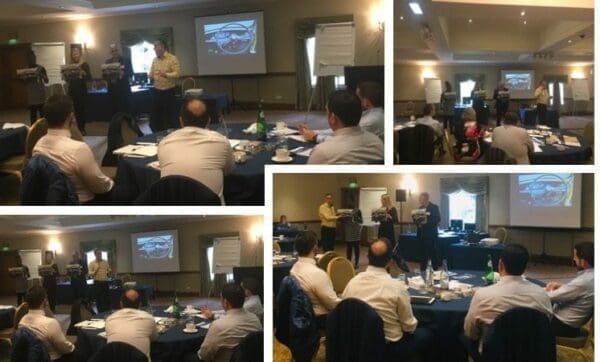
We did a driving lesson. Stopped, went back to work or college. Then the next week we did another driving lesson. Stopped, went back to work, and so on, for about 30 lessons. One per week. In learning science, this is called ‘Spaced Repetition’. Then we join a company and apparently can learning skills in one single 9-5 day. We can’t. About 150 years ago a guy called Ebbinghaus discovered this.
The Forgetting Curve
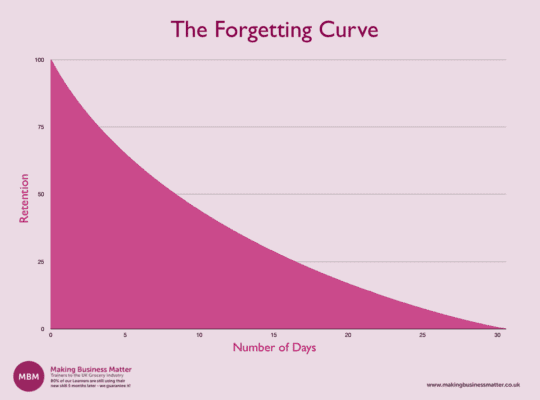
Here is his ‘Forgetting Curve’. The great thing about this science is we already know it. It just gives us a common language. We forget 80% of what we have been taught. Unless we use it. That’s the key. My daughter, Gabby, told me that each time she got in the instructor’s car she would ask, ‘What do you remember from last time?’. Brilliant. By asking questions we help people to retain more.
So, let me ask you. What are your take-aways?
Sticky Learning ® is 7 times more effective than 1-day training courses. Plus, you will get a Chain of Evidence proving your Return on Investment. Discover soft skills training that changes behaviours long term.

Keepers

Let me introduce a tool we use called, ‘Keepers’. Many years ago, our trainers used to hand out slides at the start of a training course. Every trainer around the world does the same. The Learner would then scribble on those slides throughout the day to take notes. We realised that what happened then was the Learner came back from a great course, put the slides in a drawer, with a promise to themselves to look at them again. 6-months later they had a clear-out of their desk and with a streak of guilt because they know they should have looked at them, put them in the bin.
The result? 8 hours invested in training with a very little ROI. A day lost in a very busy schedule. Shame!
Keepers helps with retention. It can’t make you do it, but it will help you remember it. Here’s what I’d like you to do. Over our short time together, if you pick-up on a tool, a tip, or something you want to remember, I’d like you to add it to your Keepers. So, by the end of our session, you have one piece of paper. Your piece of paper. With your chosen tools.
The first column you add a keyword. The second column a few notes. And the bit everyone hates but the brain loves a drawing. Finally, is there an action to do from what you captured?
Please add 1 keeper to your keepers. Please take a couple of minutes. Make sure you do the drawing!
If You Pull Cabbages
‘If you pull cabbages…’ is about 3 soft skills. These are Negotiation, Influencing and Time Management.
Negotiation Skills
Negotiation will be our first. Please listen carefully because you are going to negotiate with someone in a few minutes.
Negotiating is hard. No one enjoys conflict. But like any skill, you can improve.
Let me share with you the 5 stages of negotiation:
- Preparation
- Explore
- Propose
- Conclude
- Next Steps
We are going to take a look at stage 3 – Propose. Having been part of over 1,000 negotiations this is one of the key areas people mess-up. They say things like, ‘It would be good if you could do this’, or ‘Let’s have a look at this, ‘or ‘I must have this’. I’m going to give you a very simple, yet effective tool, taught by every negotiation training provider in the world. Then you get the opportunity to practise.
If You…Then I
This tool is called, ‘If you…then I…’. The way it works is that when you are ready to propose your deal, you construct it using these 4 words. It was my wife’s birthday recently and we went to the Friendfest in Milton Keynes. Afterwards, we stopped at a Greene King for dinner. Steaks were on offer, so we all decided to have the rump steak. Taking or order the guys says, ‘We’ve only got two left’. Do you have the rib eye steak still? Yes, lots of those. If you can do those at the same price, we’ll take them. Off he goes. And comes back with a yes.
Why would you not use it the other way around?
I have seen the dark side of negotiating where some had heard of If you Then I, but did If I, then you. The other guy cut him off after the first half of the sentence, getting what we wanted and ignoring what the other guy wanted.
So, the other guy says, ‘If I give you…’ – Shake his hand. Thank you very much. That would be excellent. Now let’s work out the details of how we…
You remember Ebbinghaus saying that unless you use what you’ve learnt you’ll lose it? Now, it’s your chance…
Buying a Car
Your task is to use ‘If you, then I…’ buying this car.

We’ll start one of you arriving on the forecourt and the salesperson says hello, and then discuss what you want and why. Then the buyer says something like, ‘If you can reduce it by £2,000, then I will pay cash’. Discuss, and then the seller uses If you Then I, and might say something like, ‘If you take it away today, then I could reduce the price by £500’.
You only have 7 minutes.
Summary: Use If you…Then I…when you want to make a proposal in a negation.
Capture any Keepers.
Influencing Skills
My daughter Gabby used to cover her face during bathtime. Telling me that if she can’t see me, then, therefore, I can’t see her, and that means she doesn’t have to have a bath.
To get anything done in your job you need to persuade, convince, sell to, argue, or let’s call it what it is influencing people. You’ll have heard of this book:

83 years ago, we realised Dale realised the importance of the power of influence. Yet every day I see people in a tough situation trying to pull tools from their influencing toolbar and it’s empty.
Beyond being nice, saying please, they have nothing. We need to equip our people to be better. More equipped. Like the book says, to win friends and influence people.
This simple tool will help.
Push and Pull

Can I have two volunteers, please?
Are you a Pusher or a Puller? Let me explain. This is an influencing tool that you can use immediately. You are either a Pusher or a Puller. Let me explain both. My wife, Gayle, and I have a friend. Donna. She is about yay high. Donna can talk the hind legs of 4 donkeys. She will tell you everything that is going on in her world. Doesn’t pause for breath. She empties her head and tells you what she is thinking, with no filter at all. I could tell you all about their sex life!
My Mum is a Puller. I’ll normally phone Mum and Dad when I have a long drive home from a client. After the hello Mum immediately asks you a question, then another, then another. How’s work boy? How’s Gayle? Is Jack at college yet? When does Gabby get home from Uni? Have you heard about your Uncle? And so on…
Click on the image below to view our full push pull influencing infographic.
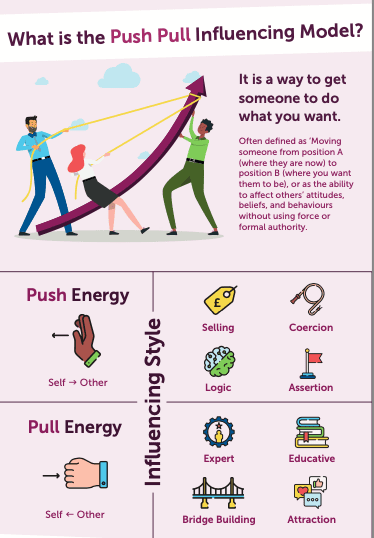
I’ve painted them in a poor light. I love them both. The point is that you will naturally be more pull or push. The challenge is not to change this. It is instead to be able to stretch where you are to the other end, in the right situation.
My accountant explained IR35 to me the other day. He spoke for about 10 minutes. I said that I still didn’t understand it. What do you think he did then? Yes, he said the same thing. Which influencing styles was he using? Yes, push. Which influencing style would have influenced me more in that situation? Yes, pull. Why? Both styles are useful. It’s about the right one for the right situation.
An Example:
I’d like a volunteer to come up. I’d like you to be a person that considers yourself more push than pull. And the same for the puller.
Pusher: Name? Where would you put yourself on this scale?
Puller: Name? Where would you put yourself on this scale?
The challenge for <name> is to be more pull at times.
The challenge for <name> is to be more push at times.
What did Ebbinghaus say about new knowledge? (Unless you use it, you’ll forget it).
Using our cars again, I’d like you to find someone else on your table. Choose one of you to be a Pusher and one to be a Puller. You are still negotiating to buy a car. Just now you are either limited to Push or to Pull. You have 10-minutes.
If you get the opportunity in the short time we have, please swap.
Summary: Use Pull & Push when you want to influence someone.
Capture any Keepers.
Time Management Skills
Our third skill is Time Management.

We call it the King of all soft skills because if you can’t do this one then everything else is much harder to do.
Cabbages, Mammoths and Frogs
We’re going to talk 3 tools in the time we have left; Cabbages, Mammoths and Frogs. But let me start with me many years ago. I was in my late twenties and my job was buying ready meals for Sainsbury’s. I loved that job. Crispy duck sampling every Friday!
I had been asked by my boss to write a presentation for the board on our market share. It was due 2 weeks on Thursday at 8 am. Noted and got on with my day. I knew I had to do it. That wasn’t the issue. I promised myself I’d do it, but I was just busy. On the week of the presentation, the task was on my mind, but I just couldn’t get to it. I was busy. Monday was a day from hell, Tuesday was no better.
Wednesday. I came in early at 7 am to make a start when no-one else was in the office. I’d opened PowerPoint when my boss had also decided to come in early. He’d like a 121. Dam. That finished, I rushed back to my desk. Did a few emails and then it was the 9.30 am meeting. That overrun. Back to my desk for 15 minutes. Listen to my voicemails. Next meeting. Finished that. Sandwich on the run, thinking I must get back to my desk to do that presentation. Afternoon meetings. A quick check of my emails. It was 6.30 pm. How did that happen?
At the time I needed my very best focus and energy, I was knackered. I worked when everyone else had gone home until 10.30 pm that night to finish it. Ready for the next morning. A poor night’s sleep because it was on my mind and did an ok job presentation the next day.
Eat That Frog Changed My Life
Brian Tracy, the time management expert wrote a book called ‘Eat That Frog’.
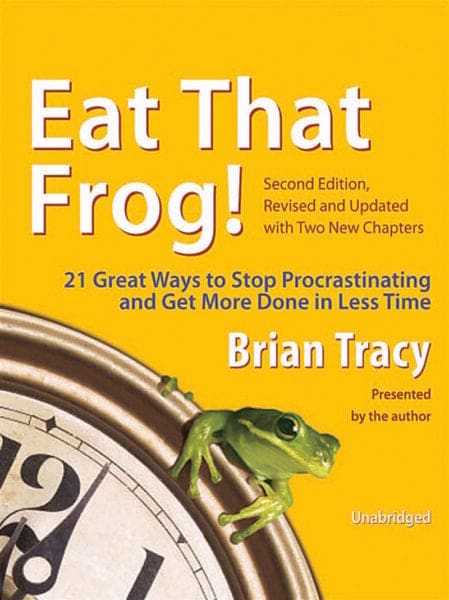
Changed my life. Brian said that if the first thing you do each day is to eat a frog, the rest of the day wouldn’t be that bad. In my words, do the biggest and most horrible tasks first because they deserve your best focus and your most energy.
Questions? Capture on your Keepers. Share your frog picture with the person next to you.
Let’s Talk About Woolly Mammoths…
I was coaching someone in Time Management. They’d made good progress on several fronts. The next challenge was projects. After a lot of questions and discussion, we arrived at a simple reason. The example he gave was moving house. He had written this on his to-do list for what seemed like forever. He had written ‘Move House’.
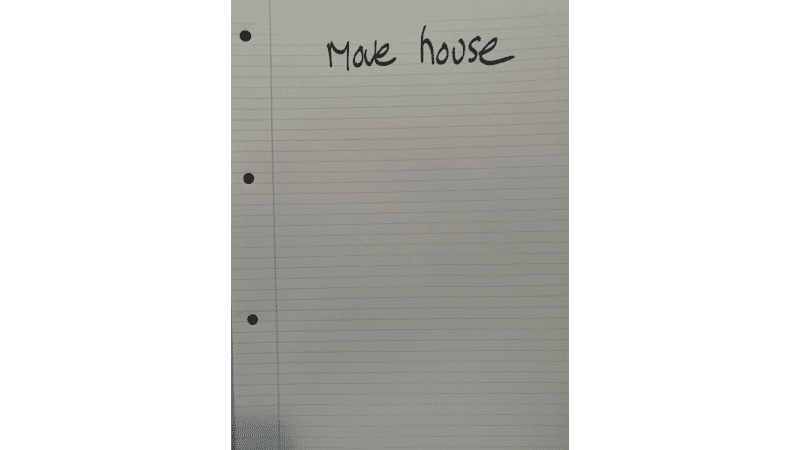
When the brain looks at that, it thinks, that’s horrible and big. There must be something else I can do. Anything…please…
What’s the best way to eat a woolly mammoth?
One bite at a time.
Instead of writing ‘Move House’, he needed to write the first step, ‘Phone Estate Agent’. The first bite.
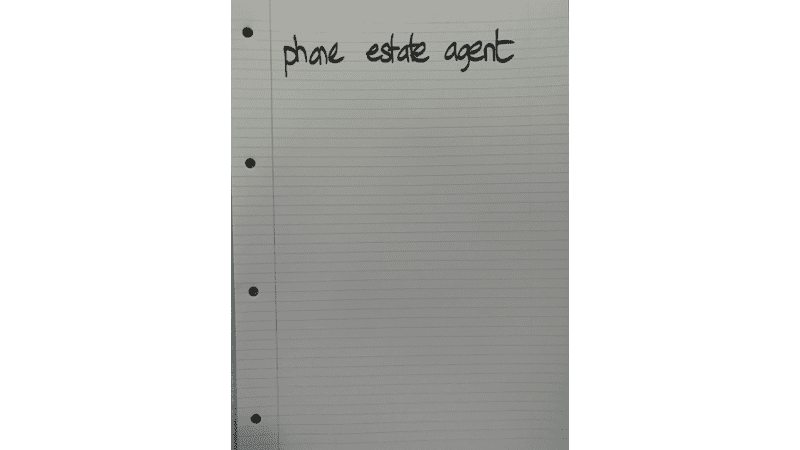
What happens is that as soon as you do the first task, you’ll find the rest start happening. A little like rolling a snowball down a hill.
I’d like you to identify one big, horrible, task that you have been putting off for a long time and instead of writing that task I’d like you to write the first practical step that will take you no more than 5 minutes.
Let’s Move onto Cabbages…
I need 6 volunteers please. Thank you.

I’m 4 years old. Coat, gloves. It’s early Spring. I’m wearing those ladybird wellies you could get from Woolies. Anyone else have a pair of those? Just me! I’m watching and trying to help my Dad. He grew cabbages in our garden. 6 of them. My dad was moaning because of their holes, ‘Bloody Butterflies’, he would say.

Some year later I realised that we are these butterflies. We go along to one cabbage. Tasty. Nibble. Then we look up, see another. Nibble. Nibble. And then another. Lovely. Until we’ve nibbled on a lot of cabbages, but not completed one.
Ever sat at your task trying to work on an important task and an email notification has popped-up? Cabbage butterfly mentality.
The time management experts call this ‘time switching’. It is one of the biggest reasons for poor productivity.
What did Ebbinghaus say? (If we don’t use it, we’ll lose it).
For the next 10-minutes I’d like you to be very honest with the person next to you and answer these questions:
- Is this you?
- How much do you do it?
- Why do you do it?
- What distracts you?
- What can you do to stop doing it?
Summary from the ELITE Scotland Workshop
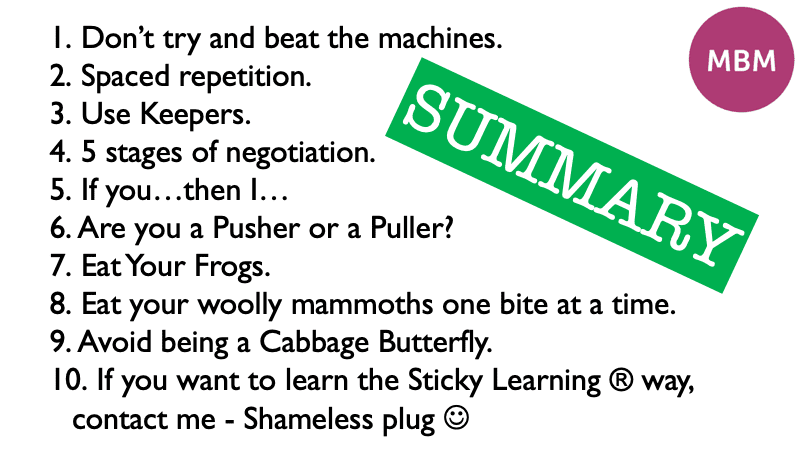
Thank you.
Feedback from a Member of the Audience
“I thought you should know your absolutely smashing! Since Thursday I have taught my Accountants lady the “If you, then I” technique (I made her draw something to remind her!) My PA now knows all about the Cabbage Butterfly and yesterday I saw a friend whose daughter is at Uni struggling to remember lecturers. I told her all about the Keepers technique, she was away to phone her daughter straight away.
It wasn’t just me that benefitted from attending your session, I have passed tips onto three different people and they, in turn, have promised to help others. It’s like a movement and all started by you.
Thanks so much for your session last week, I am sure it had as much of an impact on the others as it did on me!!
Ann
Regards
Ann Johnson
Finance Director
For and on behalf of
Blaze Manufacturing Solutions Ltd
ELITE Scotland Resources
Below, you will find a number of resources from the ELITE Scotland workshop:
ELITE Scotland Module Agenda
ELITE Scotland Company List




